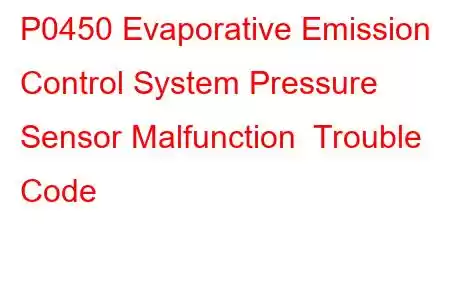P0450 Evap Emission System Pressure Sensor Malfunction
OBD-II Trouble Code Technical Description
Evaporative Emission Control System Pressure Sensor Malfunction
What does that mean?
This diagnostic trouble code (DTC) is a generic powertrain code, which means that it applies to OBD-II equipped vehicles (Dodge, Ram, Ford, GMC, Chevrolet, VW, Audi, Toyota, etc.). Although generic, the specific repair steps may vary depending on make/model.
A stored code P0450 means that the powertrain control module (PCM) has detected a malfunction in the pressure sensor circuit of the evaporative emissions (EVAP) system.
Designed to capture fuel vapors (from the fuel tank) before they escape into the atmosphere, the EVAP system utilizes a vented reservoir (usually called a canister) to store excessive vapors until the engine is being operated under the appropriate conditions to burn them thoroughly.
Fuel storage tank vapors are discharged through the pressure relief valve to the canister through a network of metal tubes and rubber hoses. Pressure that is developed when fuel is stored acts as the propellant, causing the vapors to vent through the tubes and eventually into the canister. A charcoal element, contained in the canister, absorbs fuel vapors and holds them for release at the appropriate time.
The charcoal canister, the EVAP pressure sensor, the purge valve/solenoid, the vent control valve/solenoid, and a complex system of metal tubes and rubber hoses (stretching from the fuel tank to the engine compartment) are typical components of the EVAP system.
The EVAP system utilizes engine vacuum to draw fuel vapors into the intake manifold where they can be burned instead of being released into the atmosphere. The PCM electronically controls the purge control valve/solenoid which is the gateway of the EVAP system. It is responsible for regulating intake vacuum to the EVAP canister so that fuel vapors may be drawn into the engine when conditions are ideal for fuel pressure vapors to be burned most effectively.
The EVAP pressure sensor allows the PCM to monitor EVAP system pressure. It is almost always located in the fuel tank and integrated into the fuel pump/fuel level sending unit housing. If EVAP and/or fuel tank pressure appear out of a pre programmed range, over a set period of time and under certain circumstances, a code P0450 will be stored and the malfunction indicator lamp (MIL) may be illuminated.
Related evaporative emission trouble codes include P0451, P0452, P0453, P0454, P0455, P0456, P0457, P0458, and P0459.
Code Severity & Symptoms
The code P0450 is associated with emissions regulation and will not seriously affect engine drivability. It should not be classified as severe.
Symptoms of this code may include:
In most cases, there will be no symptoms exhibited with a code P0450 Slightly diminished fuel efficiency An illuminated MIL (malfunction indicator lamp)Causes
Potential causes for this code to set are:
Faulty EVAP pressure sensor Loose, defective, or missing fuel cap Clogged fuel tank pressure relief valve Broken, collapsed, burned, or otherwise damaged EVAP hoses/lines Cracked or broken charcoal canisterDiagnostic and Repair Procedures
A diagnostic scanner, a digital volt/ohmmeter, a reliable vehicle information source (All Data DIY), and possibly a smoke machine will be helpful in diagnosing a code P0450.
I usually start with a visual inspection of EVAP system hoses and lines; focusing on lines that are routed near sharp edges or hot exhaust components. Remove the fuel cap and inspect the seal, then screw it back on properly.
Connect the scanner to the vehicle diagnostic port and retrieve all stored codes and freeze frame data. Make a note of this information as it may prove to be very helpful if this turns out to be an intermittent code.
Read: 44


